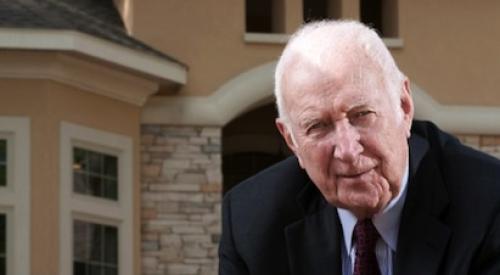|
 |
The fourplexes are usually built in compact communities — 60 to 150 units — that also feature a small clubhouse. The homes offer single-level living with an attached two-car garage and all exterior maintenance handled through the condo association. The four floor plans range from 1,300 to 1,900 square feet. Probably most important, the price of a two- or three-bedroom home is often about half what a move-down couple can get by selling their larger single-family home. And Epcon develops its communities close to suburban subdivisions, so moving down doesn't necessarily require buyers to move away from friends and family.
While Epcon only recently showed up in Professional Builder's Giant 400 rankings, the firm is anything but new. Partners Ed Bacome and Phil Fankhauser began building their innovative pinwheel cluster condos around central Ohio in the mid-1980s. Their original firm, Epcon Communities, is still the largest Epcon builder, but it operates outside the franchise network, fine-tuning the product and business processes franchisees use from South Carolina to Seattle. The product is so repetitive and the processes so standardized that Bacome and Fankhauser describe the business model as "paint-by-the-numbers simple." Only 45 percent of new franchisees have any previous building experience. The rest come from professions as doctors, lawyers, bankers, real-estate brokers, engineers and dentists.
Resistant to RecognitionBacome is a licensed lawyer, Fankhauser a long-time central Ohio land developer and entrepreneur. They still resist describing their firm as a housing giant. "We don't think of ourselves that way," Bacome says. "We're flattered, but our business is really a collection of small, independent builders. They just all do the same product."
Fankhauser admits this below-the-radar operating style was calculated. "We found a unique product niche. The longer we could go without talking about it, the more we could get done without significant competitors noticing. But we're now way past the point where we can hide," he says.
They did their first project as home builders in 1986, after observing that Columbus, Ohio, empty nesters — ready to sell a big, suburban home and move down to something smaller and easier to maintain — had few options. "A lot of couples were renting two-story townhouses," Fankhauser recalls, "because that's all they could find that they could afford on a fixed income. Our first development was 92 units, all the same floor plan, 975 square feet, priced at about $59,000. We came up with a product that looks good architecturally — something empty nesters can be proud to live in — and yet it doesn't strap them financially or wear them out to maintain. And most important, it's repeatable. We can build it over and over."
That's what the partners have done for 20 years, although they constantly tinker with their product. "We were on our 12th unit in that first project when Ed and I made our first design change," Fankhauser says. "We listen to our customers. Who can tell you more about the way a home lives than the people actually living in it? It's easier to sell people what they want than to try to sell them what you want to build. As long as we keep improving our product, anyone who tries to copy it will always be a step behind."
Growth Via FranchisingBy the late 1980s, Bacome and Fankhauser realized the niche they were exploiting existed almost everywhere, not just in Columbus and that, thanks to the aging baby boom generation, it was about to grow substantially. But the partners decided they'd rather license their product to other builders than grow their own business to a national scale. "We opted to go into licensing because neither of us wanted to spend all that time on airplanes, flying to other cities to do far-flung projects," Fankhauser recalls.
"If we tried to take what we do to other markets, we'd have had to put a lot more capital at risk," Bacome reasons, "and build a complex organization with a lot more layers of management. We might have had to go public. It would be a much different business model than we have now."
They began licensing builders outside central Ohio in 1988, converting to franchising in 1995. "As we grew, we encountered states with laws that drove us to franchising," Bacome says. "Franchising is more complicated because it requires an annual offering circular. Ours is over an inch thick. But we finally came to grips with the fact that, if we want to operate everywhere the market beckons, we had to go to franchises. They're a common part of the business world in every state."
How Big Can It Get?Fankhauser and Bacome see few impediments to growth. Not only are baby boomers continuing to flow into their niche, but an additional target market is also showing up. "Single working women," Fankhauser says. "Younger women who have not married and middle-aged women who are divorced find our communities comfortable and secure. The presence of our primary market — empty nesters — heightens that sense of security because the older people are always there. And the empty nesters prefer to be in a community that is not age-restricted. They don't want to feel like they've been put out to pasture. So these two groups are not only compatible, but complementary."
What about the possibility of competition from publicly held national builders?
"Occasionally, we've butted heads with the big nationals," Bacome says. "But they're always hung up on how many units they get on an acre of land. They end up doing projects at 10 to 14 units per acre. We can't achieve that with our much larger footprint. Our density maxes out at about 5½ to 6 units per acre, so our land cost per unit is higher. But that's not important. It's profit per acre that matters. We beat them because our franchises have much lower overheads."
"We haven't set any limits," says Fankhauser, "Our biggest concern is that we have to maintain high levels of satisfaction among both our buyers and our franchisees as we grow. If our franchisees are successful and our buyers are happy, this is a fun company to manage."
|












